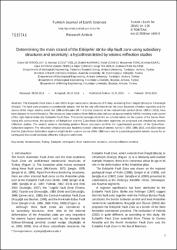Determining the main strand of the Eskisehir strike-slip fault zone using subsidiary structures and seismicity: a hypothesis tested by seismic reflection studies

Göster/Aç
Erişim
info:eu-repo/semantics/openAccessTarih
2015Yazar
Seyitoğlu, GürolEcevitoğlu, G. Berkan
Kaypak, Bülent
Güney, Yücel
Tun, Muammer
Esat, Korhan
Uyar AlDaş, G. Gülsev
28 readers on Mendeley
Üst veri
Tüm öğe kaydını gösterÖzet
The Eskisehir Fault Zone is one of the major neotectonic structures of Turkey, extending from Inegol (Bursa) to Cihanbeyli (Konya). The fault zone presents a considerable seismic risk for the city of Eskisehir but the exact locations of active segments and the source of the major seismic event, the 1956 earthquake (M = 6.5) that occurred in the instrumental period (from 1900 to 2013), have been debated in recent literature. The structural data obtained from field studies indicate an approximately N60W-trending main strand of the right lateral strike-slip Eskisehir Fault Zone. This trend corresponds to the en echelon bends on the course of the Sarisu River. Using this concurrence, the positions of Bahcehisar and the Cukurhisar-Sultandere segments are proposed and checked by seismic reflection studies. The seismic sections disclosing positive flower structures confirm the hypothesized position of the Cukurhisar-Sultandere segment. The relocation of epicenters and focal mechanism solutions of seismic events in 1956, 1990, 2010, and 2013 indicate that the Cukurhisar-Sultandere segment might be the rupture source of the 1956 event and is a possible potential seismic source for an earthquake that could seriously affect the Eskisehir settlement.

















